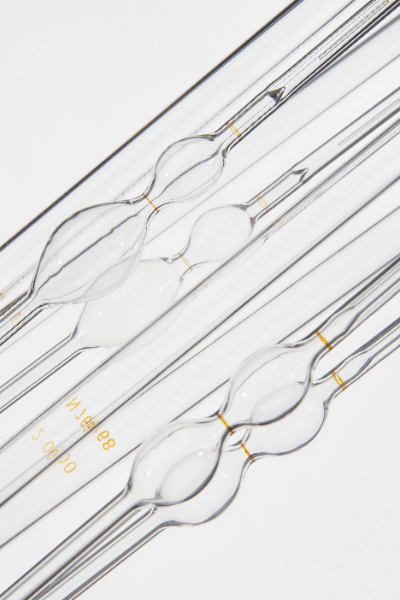What Is a Viscometer?
 A viscometer is a measuring instrument used to determine the viscosity of a liquid.
A viscometer is a measuring instrument used to determine the viscosity of a liquid.
Viscometers are used in the chemical industry, for example, to measure the viscosity of adhesives and paints. Viscosity is also very important in the food and beverage industry. Even food products made in the same way may not be viable as products if they have different viscosities, so viscometers are widely used in the food and beverage industries.
Viscometers can be divided into two main types: those that simply measure the time it takes for a liquid to pass from the top to the bottom, and those that use a rotating spindle.
Uses of Viscometers
Viscometers are used in the food, beverage, and chemical industries to measure the viscosity of products.
If the taste is the same, but the viscosity is different, the sensation when pouring into a container or the sensation when actually drinking the product will be different, resulting in a completely different food product. Therefore, viscosity is an important indicator of food products. Viscosity is also an important indicator of the chemical industry. If the viscosity is high, for example, an adhesive applied to a wall will not drip, making it easy to use, but on the other hand, it will be difficult to handle and handle.
Principle of Viscometers
Viscometers are devices used to measure the viscosity of liquids. Viscometers are based on a variety of principles, but the main principles used are as follows:
1. Vibration Damping
The viscosity of a liquid is measured by measuring the damping of vibration by a vibrating body. When a vibrating body vibrates in a liquid, the vibration is damped by the viscous resistance generated in the liquid. By measuring the degree of damping, the viscosity of the liquid is calculated.
2. Pressure Loss
Viscosity of a liquid is measured by measuring the flow velocity and the pressure drop of the fluid as it flows through a pipe. Liquid is poured into a pipe set to flow at a constant flow rate and the pressure drop is measured. If the viscosity of the liquid is high, the pressure drop will be large, and thus viscosity can be measured.
3. Falling Velocity (Time)
Viscosity of a liquid is measured by measuring the speed of a small sphere falling into the liquid and the time taken by the fluid to flow down. Since the speed of a falling sphere and the time it takes for the fluid to flow depend on the viscosity of the liquid, the viscosity of the liquid is calculated by measuring these speeds.
Types of Viscometers
The method of measuring viscosity varies from device to device, with different characteristics and measurement ranges. The main types of viscometers are capillary viscometer, falling-ball viscometer and rotational viscometer.
1. Capillary Viscometer
A capillary viscometer is one of the simplest and most straightforward methods of measuring viscosity. A fluid is poured into a capillary tube at a constant temperature and the time taken for the fluid to pass through the capillary tube is measured. It is very simple, but if the viscosity is too high, the fluid will take a very long time to pass through the container, or will not flow at all due to pressure loss. Depending on the shape, there are the Canon-Fenske, Ueberode, and Ostwald types.
2. Viscosity Cup
Similar to the capillary viscometer, the viscometer cup measures the outflow time of the fluid flowing from the cup. Each cup has a specific viscosity range and can measure almost any viscosity, but the disadvantage is the large measurement variation.
3. Falling-Ball Viscometer
A falling-ball viscometer, such as the Heplerian falling-ball viscometer, fills a container with fluid and measures the time taken for the pebbles to fall between the lines. Viscosity is determined by Stokes’ equation. The viscosity range is wide, but it cannot measure paint or ink, for which the pebbles are not visible.
4. Type B Viscometer
The B-type viscometer is the most commonly used rotational viscometer in industrial applications. It rotates a rotating body called a spindle in a liquid and converts the torque into a viscosity value. It is very easy to use, but there is a possibility of a slight error due to the thickness of the spindle.
5. Tuning-Fork Viscometer
A tuning-fork viscometer is another type of viscometer. The tuning-fork vibrometer resonates an oscillator in a liquid and determines viscosity from the excitation force required to move the oscillator at a constant amplitude. The tuning-fork vibration method is very sensitive and can be used when precise measurement is required.
Tuning-fork vibrometers can also be used to measure viscosity in-line, detecting changes in vibration as viscosity. Inline viscometers can continuously measure viscosity in flowing fluids, so they are used in lines and tanks where constant viscosity measurement is required.